Kinetics - The Maxwell–Boltzmann Distribution and Catalysts (A-Level Chemistry)
The Maxwell–Boltzmann Distribution and Catalysts
Molecules in a Gas
Understanding the Maxwell-Boltzmann Distribution
If you consider all the molecules in a gas, not all of the particles will have the same amount of kinetic energy. Some will have lots of kinetic energy, whilst some will have less kinetic energy. We can therefore plot a Maxwell-Boltzmann Distribution to show the distribution of energies between different molecules.
In terms of its definition, the Maxwell-Boltzmann Distribution represents the distribution of molecular energies in gases. It is a plot of the number of particles, where each particle has a particular energy.
Plotting a Maxwell-Boltzmann Distribution
You should be able to draw, label and interpret a Maxwell-Boltzmann distribution plot like the one below.
Here are some rules you need to know before you interpret a Maxwell-Boltzmann distribution:
- Area under curve – the area under the curve is a measure of the total number of particles present.
- Activation energy – A dotted line or straight line is used to represent the activation energy.
- Shaded region – the shaded region to the right of the activation energy line represents the only particles that will react when they collide. These are the particles that have sufficient energy that is more than the activation energy.
- Median (most common) particle energy – the peak of the curve represents the most common energy of any single particle in the reaction.
- Mean particle energy – there is a line to the right of the peak, which shows the mean particle energy. This is higher than the median, because often very high energy particles are present, which distort the mean.
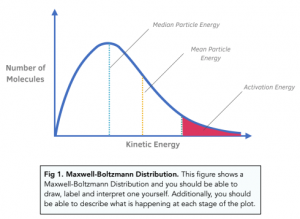
The Maxwell-Boltzmann Distribution and Temperature Changes
As we saw on the previous chapter, increasing the temperature of a system will increase the kinetic energy of reactant particles so that a larger proportion of the particles have at least in the system will have enough energy to undergo successful collisions.
This can be represented on a Mazwell-Boltzmann Distribution curve and you should also be able to draw and interpret Maxwell-Boltzmann Distribution curves for different temperatures:
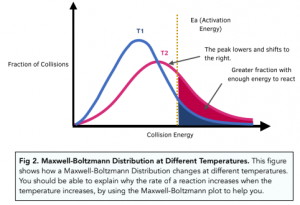
According to this Maxwell-Boltzmann distribution:
- When the temperature is increased from T1 to T2, the shape of the Maxwell Boltzmann distribution changes. The peak lowers and shifts to the right.
- According to the Maxwell Boltzmann distribution, increasing the temperature increases the proportion of particles that have sufficient energy (at least the activation energy) to react. This can be observed from the shaded region which increases in area when the temperature is increased.
- As a result of there being a greater proportion of particles having sufficient energy to react, the rate of reaction increases.
- The graph shows that even a small increase in temperature can lead to a large increase in rate.
Catalysts and Rate of Reaction
Mechanism of Catalysts
A catalyst is a substance that increases the rate of a chemical reaction without being changed in chemical composition or amount.
The catalyst works by providing an alternative route to a reaction which has a lower activation energy, which means that a smaller amount of energy is needed to start a reaction.
The way catalysts achieve this depends on whether they are heterogeneous or homogeneous catalysts.
Heterogeneous Catalysts
A heterogeneous catalyst is in a different physical state (or phase) from the reactants. They provide a surface for the reaction to take place on, which facilitates reactant molecules to react with each other at a lower activation energy.
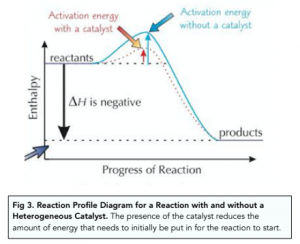
The process by which heterogeneous catalyst work involves three steps:
- Adsorption – Reactant molecules arrive at the surface of the solid heterogeneous catalyst and form weak bonds with it by a process known as adsorption.
- Reaction – Intermolecular bonds in the reagent particles weaken and eventually break, resulting in the formation of free radicals with unpaired electrons. These can then form new bonds with each other to form the product of the reaction.
- Desorption – The newly formed products detach from the surface of the catalyst.
An example of a heterogeneous catalyst would be solid iron used as a catalyst for the formation of ammonia in the Haber Process.
Homogeneous Catalysts
A homogeneous catalyst is in the same physical state (or phase) as the reactants.
Homogeneous catalysts work by forming intermediate species with the reactant particles, which then react to form the products and reform the catalyst. The activation energies of this stepwise reaction are overall lower than the activation energy for the uncatalysed reaction.
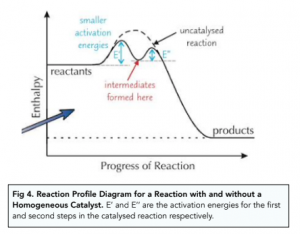
Effect of Catalysts on the Rate of Reaction
Re-Use of Catalysts
If a catalyst is present at the start of a reaction, it will also be present at the end of the reaction. This means that catalysts can be re-used in several reactions.
You should be able to explain the qualitative effect of using a catalyst on the rate of reaction using a Maxwell Boltzmann distribution:
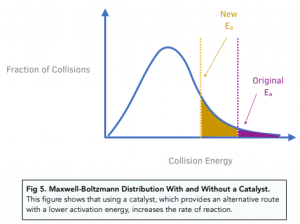
According to this Maxwell-Boltzmann distribution:
- Only the particles that are represented by the area to the right of the activation energy will react when they collide.
- When the catalyst is used, an alternative route is provided with a lower activation energy. This is represented by the shift in the line, labelled activation energy, to the left.
- According to the Maxwell Boltzmann distribution, using a catalyst increases the proportion of particles that have sufficient energy (at least the activation energy) to react. This can be observed from the shaded region which increases in area when the catalyst is used.
- As a result of there being a greater proportion of particles having sufficient energy to react, the rate of reaction increases.
Catalyst Use in Industry
The Haber Process mentioned previously is an example of how catalysts can be used in industry.
Catalysts are very widely used in industrial processes for their multiple economic benefits:
- Catalyst use lowers production costs. By allowing for the reaction to take place at a lower temperature and pressures, which decreases energy demands; as well as by allowing more product to be formed in less time.
- Catalyst use can improve the properties of reaction products. For example, poly (ethene) made in the presence of a catalyst is much denser, more rigid and withstands heat better than if produced without.
The use of catalysts in industrial processes also has environmental benefits:
- Catalyst use makes industrial processes more sustainable. If industrial processes can operate at lower temperatures and pressures, less fossil fuels have to be burned and CO2 emissions are reduced.
- Catalyst use reduces waste production. Using catalysts improves at the atom economy of the reaction hence producing less unwanted by-products.
FAQs
Kinetics is the study of the rate of chemical reactions and the factors that affect that rate. It focuses on how fast a reaction occurs and how that speed can be controlled.
The Maxwell-Boltzmann Distribution is a statistical model that describes the distribution of particle speeds in a gas. It predicts that the speed of particles in a gas will follow a normal distribution, with the most particles having a speed close to the average and fewer particles having speeds far from the average.
The Maxwell-Boltzmann distribution is a fundamental concept in statistical physics and is used in many areas of science and engineering, including:
Thermodynamics: The distribution is used to calculate the average kinetic energy of gas molecules, which is related to temperature. It is also used to calculate the heat capacity of gases and the distribution of energy levels in a system.
Chemical kinetics: The distribution is used to calculate the probability of molecular collisions and the rate of chemical reactions. It is also used to study the distribution of molecular velocities in reactions.
Molecular spectroscopy: The distribution is used to interpret the shape of spectral lines and to calculate the population of different energy levels in molecules.
Material science: The distribution is used to study the behavior of atoms and molecules in solids, liquids, and gases. It is also used to model the diffusion of particles in materials.
Astrophysics: The distribution is used to study the properties of stars, planets, and other astronomical objects. It is used to model the temperature and composition of stellar atmospheres and to study the dynamics of galactic structures.
Overall, the Maxwell Boltzmann distribution is a versatile tool that is used in many areas of science and engineering to describe the properties and behavior of atoms and molecules.
The Maxwell-Boltzmann Distribution is important in chemical reactions because it helps to explain the rate of reaction. The speed of particles affects the rate of collision between particles, which in turn affects the rate of reaction. By understanding the distribution of particle speeds, we can better predict and control the rate of reaction.
The Maxwell-Boltzmann distribution describes the distribution of molecular speeds in a gas, and this distribution is strongly affected by changes in temperature. Specifically, as the temperature of a gas increases, the average speed of the gas molecules increases, and the shape of the distribution changes.
At higher temperatures, the Maxwell Boltzmann distribution shifts to higher speeds, meaning that a greater proportion of molecules have higher speeds. This is because higher temperatures cause the gas molecules to move more rapidly and with greater kinetic energy. As a result, the peak of the distribution shifts to higher speeds, and the width of the distribution broadens, indicating that a greater range of speeds is present in the gas.
Conversely, at lower temperatures, the distribution shifts to lower speeds, indicating that a greater proportion of molecules have lower speeds. This is because the gas molecules move more slowly at lower temperatures, with less kinetic energy. As a result, the peak of the distribution shifts to lower speeds, and the width of the distribution narrows, indicating that a narrower range of speeds is present in the gas.
Overall, the Maxwell-Boltzmann distribution and temperature changes are strongly linked. Changes in temperature cause changes in the average speed of the gas molecules, which in turn affects the shape and width of the distribution. This relationship is fundamental to the study of thermodynamics, chemical kinetics, and many other areas of science and engineering.
Catalysts are substances that increase the rate of a chemical reaction without being consumed by the reaction. They work by providing an alternative reaction pathway with a lower activation energy, making the reaction occur faster.
Catalysts affect the rate of reaction by providing an alternative reaction pathway with a lower activation energy. This allows more particles to collide with enough energy to react, increasing the rate of reaction.
There are several different types of catalysts, including heterogeneous catalysts, homogeneous catalysts, and enzymes. Heterogeneous catalysts work by bringing the reactants into close contact, increasing the rate of collision. Homogeneous catalysts dissolve in the reaction mixture, allowing them to interact directly with the reactants. Enzymes are biological catalysts that are specific to particular reactions.
Yes, catalysts can be used to control the rate of reaction in real-life applications. For example, catalysts are used in industrial processes to increase the efficiency of chemical reactions and to reduce waste. They are also used in automobiles to control the rate of reaction in the catalytic converter, reducing harmful emissions.
Scientists choose the right catalyst for a reaction by considering several factors, including the type of reaction, the reactants involved, and the desired outcome. They may also conduct experiments to determine which catalyst is most effective for a particular reaction.





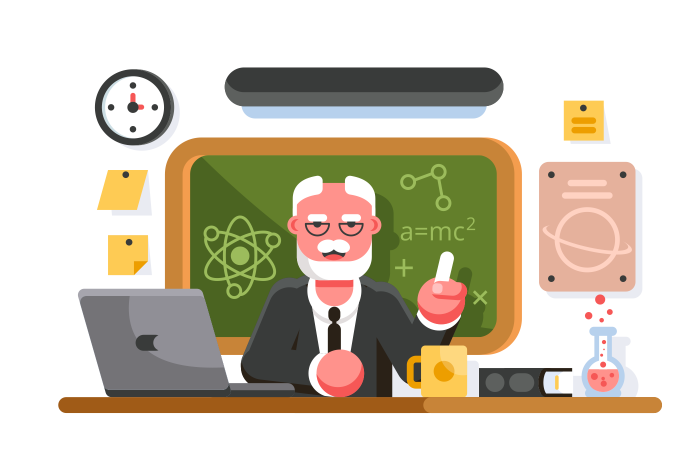
Still got a question? Leave a comment
Leave a comment